Definitive Estado de Sonora notes
Though the Sonoran government had decided the format of the definitive notes by September 1913, for some reason arranging the printing contract took a long time. On 21 October 1914 Carlos Randall, the State Treasurer, called at the offices of the American Bank Note Company in New York with a commission from Maytorena dated 12 Octoberwritten by Maytorena at his camp at Kilmetro 5, opposite Naco (AGHES, Fondo Oficialidad Mayor, tomo 2993) and a letter of introduction from the National City Bank of New York and asked for a quotation for the five low-value denominations, in accordance with the sketches he provided. Originally, the 25c, 50c and $1 notes were to have the four signatures printed in facsimile, whilst the $5 and $10 notes would carry facsimiles of the signature of the Governor and Secretary, with the other two signatures to be written in by handABNC, folder 470, Estado de Sonora (1914-1937). The ABNC in fact put four signatures on the $5 and $10 notes by mistake (ABNC, folder 470, Estado de Sonora (1914-1937) telegram E. N. Gibbs, Hermosillo to ABNC, New York, 14 April 1915) This caused a good deal of trouble due to the fact that the decree authorizing the issue only called for two signatures and a new decree had to be issued. Decree núm. 51 of 11 December altered the design by providing for the signature of an Interventor to be added to the three already proposed (ibid., letter, E. N. Gibbs, El Paso to ABNC, 18 April 1915).
Soon after Randall asked about printing the other values and on 5 November the ABNC wrote to him at the Hotel Belmont in New York with a quote for the three higher denominations. They suggested that in view of the fact that decree núm. 13 called for underlying tints of yellow, blue and red on the $1, $5 and $10 notes, the underlying tints on these three values be green, purple and brown. Randall acknowledged both quotations on 7 November and accepted the one for the low-value denominations but said that nothing more could be done about the high-value denominations until the state issued the requisite decree (which it did on 11 December (decree núm. 52There were to be three extra series, L to M, each containing twenty thousand $20 notes; six thousand $50 and three thousand $100 (Periódico Oficial, 18 December 1914)). He was returning to Sonora and would write from there. On 10 November the ABNC sent complete face and back models of the five low-value denominations to Randall at the Hotel Belmont for his approval (and a set of photographs of the models to take to Mexico)ABNC, folder 470, Estado de Sonora (1914-1937). Because they did not have the necessary photographs the ABNC used vignettes of the British royal family.
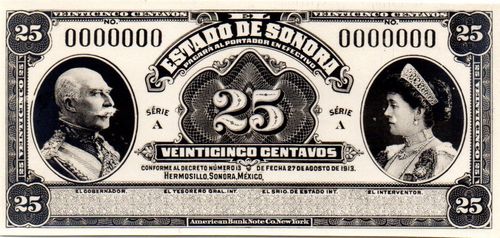
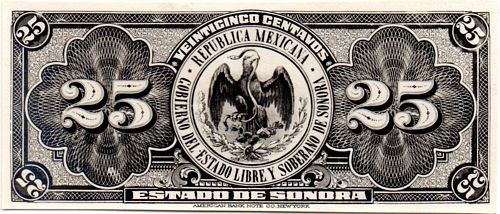
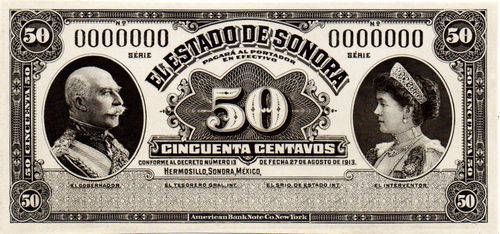
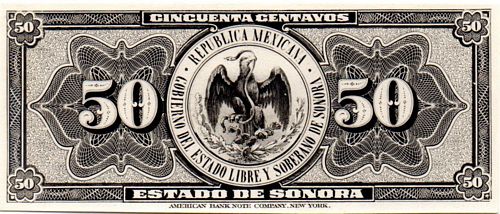
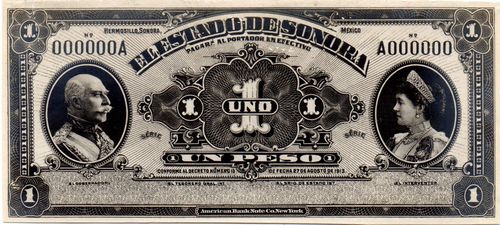
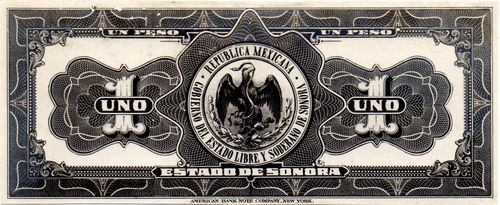
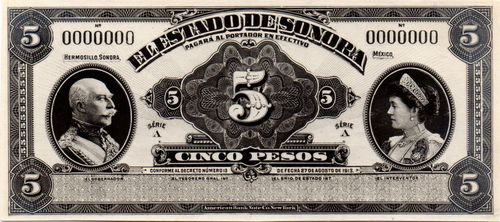
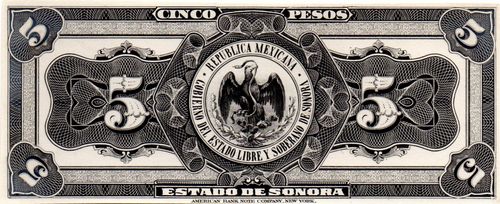
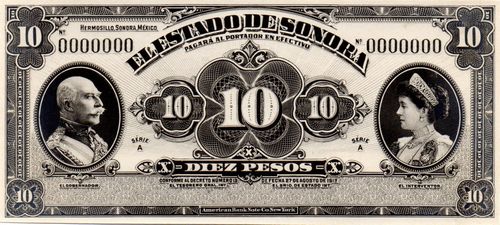
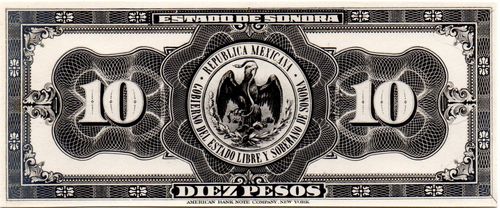
On the same day Fortuna Vizcayno, the Customs Administrator at Nogales, passed on a message from Maytorena that Randall was not to sign the contract and, if he had already signed it, to find out how much ABNC would need to cancel it. This was a momentary setback due to the temporary lack of funds, and on 24 November Randall wrote from Tucson that everything had been satisfactorily arranged and that he would send photographs of Madero and Pino Suarez as soon as he obtained them. Randall sent the photographs and a cheque for the first payment on 3 Decemberibid. The printers were given a choice of two photographs of both Madero and Pino Suárez. The portrait of Madero was engraved from a postcard (no identifying reference) by Robert Savage and approved on 29 December 1914: that of Pino Suárez from a portrait photograph (with reference No 2./Es Prop. 'Marst'/Mexico) by Edwin Turner and approved on 30 December 1914 (ABNC).
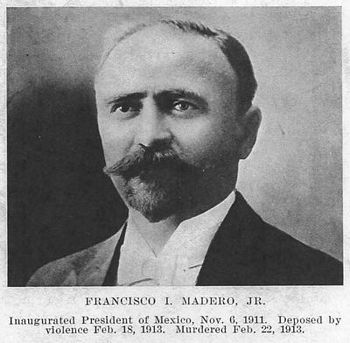
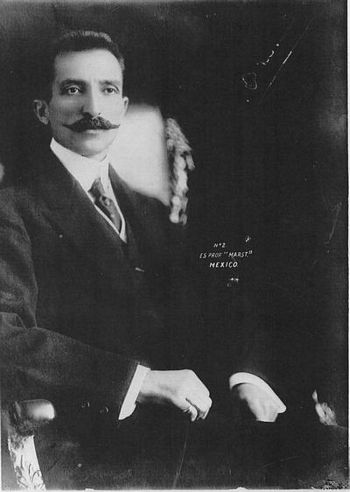
The photographs from which the American Bank Note Company produced its vignettes
Randall returned the proofs, with the signed approval of Maytorena on each, on 2 January 1915. By 16 January Randall was asking when the notes would be ready as they were badly needed and on 21 January was threatening to give the order for the further three million pesos to another concern if the ABNC did not deliver on time. The ABNC replied that they had told Randall that, in view of having two special vignettes of portraits to engrave, the best they could do would be three months from the time they had received approval of their models. The order had been entered on 9 December so the promise of starting delivery in the first week of March would just make the required three months. However, by working overtime to the fullest extent they could commence delivery of the 25c and 50c notes by 20 February and probably complete those two denominations in about three weeks, in the meantime rushing work on some of the other denominations and trying to make shipmentsibid..
Consignments began to arrive in Hermosillo on 8 March and continued until 28 AprilAGHES, Fondo Oficialidad Mayor, tomo 3024. (see Consignments). The ABNC also produced ten seals with the legend ‘TESORERIA GENERAL – SONORA’ to use to validate the notes. The line plate for these was prepared in the ABNC factory and the electrotypes by Ringler & Co. These electrotypes were mounted on wooden blocks so that they could be used in a printing pressABNC, folder 470, Estado de Sonora (1914-1937): AGHES, Fondo Oficialidad Mayor, tomo 3024. The ABNC also provided a list of countermarks (contraseñas) (JR-X, etc.) which were applied to the notes in the government printing office before they were put into circulationAGHES, Fondo Oficialidad Mayor, tomo 3024).. By 27 April travellers from Hermosillo were reporting that the new issue was being stamped in the government printing shop and would be put into circulation within a few daysPrensa, 30 April 1915.
In early spring E. N. Gibbs, of the ABNC, met Randall in Chihuahua. When he arrived in El Paso on 9 April he found a telegram from Randall asking him to go to a meeting in Nogales to discuss the second issue of notes. If Randall was not there, then Salvador Díaz, the Customs collector, would give him a safe conduct pass through to HermosilloABNC, folder 470, Estado de Sonora (191401937). Though Gibbs did not want to go to Hermosillo ("From all accounts Hermosillo isn’t one of the quietest places in the Republic just now"), he did and on 14 April reported that he had received an order for the second issue. Randall in fact wrote from Tucson on 14 April confirming the order for an extra three million pesos authorised by decree núm. 52ibid..
Gibbs got back to El Paso on 18 April, having left Hermosillo on 16 April. "They burnt a bridge in front of the train on the way up which delayed us about 10 or 11 hours and I was eighteen hours without food and jolly nearly starved to death". He added that when he left "they were just commencing to issue the notes, having printed the Government seal and series. I was able to buy a set – (I wanted to show them to de la Garza) but found I had to pay 15c for them (about 6½ to 1) which is about the same price as the bank notes of the Nacional and London Bank. I was very surprised at this because they are not bank notes but simply state notes and their value should only be about 8c (12½ to 1). I heard rumors that there was actual gold behind this issue of $10,000,000 Pesos and that more would be put up for the additional issue of 3,000,000. I was not able to confirm this but believe it to be true as I can account for no other reason for price of notes – unless it’s the marvelous superiority of the printing!ibid., letter, E. N. Gibbs, El Paso to ABNC, 18 April 1915”.
On 15 May the ABNC sent Randall, in Tucson, complete designs of the $20, $50 and $100 notes and Randall telegrammed his approval on 26 May. However ABNC wanted the designs returned so that they could be absolutely certain and asked for them on 2 June, 16 June and 7 July. When, on 20 July, Randall asked when the notes would be ready as they were needed very badly, ABNC replied that it was impossible to give a delivery date until the designs were returned. Randall sent the designs from Nogales on 22 July. The company sent off back proofs for the $20 and $100 notes on 10 August and back proof of the $50 and face proofs of all three denominations on 17 August.
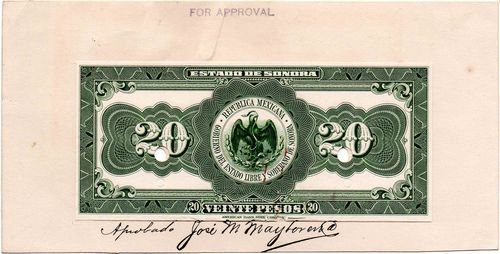
M3824p $20 reverse proof approved by Maytorena
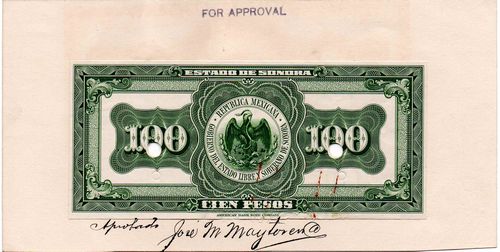
M3826p $100 reverse proof approved by Maytorena
On 20 September the ABNC reported that the notes were all ready for shipment and asked for its third and final payment. They wrote again to Randall on 6 October and finally shipped this second issue to Nogales on 13 Octoberibid.. However, on 2 November Wells Fargo & Co Express, at Nogales, Arizona reported that Joffroy y Levin would not accept the shipment as Maytorena had left without giving them any instructions. So on 8 November the ABNC wrote to Randall to ask him to contact Well Fargo and advise them what disposition he wished made of the caseibid.. Joffroy y Levin finally took possession of the strongbox on 31 January 1916ibid., memorandum 13 February 1929 but the notes were not distributed and eventually passed on to the movie money/curio market.
The 25c, 50c, $1, $5 and $10 values, when finally printed, were dated 1 January 1915 and the $20, $50 and $100 dated 1 March 1915. The lower-value notes have the printed signatures of Maytorena as Governor, Alberto Hugues as Interim Secretary of State (El Srio. de Estado Int.), Luis Sotomayor as Interim Treasurer General and Enrique Astiazarán as Interventor: the three highest values are only known as remainders with just Maytorena’s and Hugues’ signatures and with no seal or countermark (contraseña) on the reverse.
|
A political moderate, Maytorena had originally backed Bernardo Reyes and then Madero. In 1910 he organised the Junta Revolucionaria Mexicana in Nogales, Arizona and became one of Madero’s earliest disciples in Sonora, as he claimed, ‘to defend its sovereignty’. He was elected governor but after Huerta seized the presidency, on 22 February 1913 he left for a six-month sabbatical in the United States, returning on 4 August. Maytorena was always at odds with Carranza and on 23 September 1914, counting on the support of Villa, he disowned Carranza. His faction fought against Elías Calles in Agua Prieta and Angel Flores in Navojoa. On 1 October 1915 Maytorena handed over the governorship to Carlos Randall and left for the United States. He died on 18 January 1948. |
|
| Alberto Hugues was Oficial Mayor Encargado del Despacho to Interim Governor Padilla in January 1913 and named Inspector General de Aduanas on 11 September 1913AGHES, Fondo Oficialidad Mayor, tomo 2965. He took over as Oficial Mayor from Cespedes on 16 July 1914AGHES, Fondo Oficialidad Mayor, tomo 2984. He was Secretario General de Gobierno in March 1915. | |
| Luis Sotomayor was Administrador de Rentas in Alamos and instructed to move to Hermosillo in August 1913. Randall temporarily handed over his office as Treasurer to Contador Sotomayor on 26 March 1914. | |
| Enrique Astiazarán, like Randall, was a member of a petit bourgeois family from Guaymas. He was appointed by Sotomayor as Interventor on 24 September 1914AGHES, Fondo Oficialidad Mayor, tomo 2993. |
The print records of the American Bank Note Company are detailed in Print details.
Circulation
There are a few references to these notes circulating.
On 9 February 1915 Sahuaripa had been instructed to forewarn people that all the state’s notes were going to be exchanged by the Tesorería GeneralAGHES, Fondo Oficialidad Mayor, tomo 3024. and on 24 March, by which time the notes had begun to arrive from the American Bank Note Company, it received details from the Oficial Mayor of how this amortisation would be effectedibid.. The old notes were to be received in payment for taxes whilst holders would be informed that they should send them to the Tesorería, by means of the Administraciones de Rentas, to change them for the new issue that would soon be in circulation.
As reported above, E. N. Gibbs of the ABNC reported that by 16 April the authorities were just commencing to issue the notes, having printed the Government seal and series, and he was able to buy a setABNC, folder 470, Estado de Sonora (1914-1937) letter, E. N. Gibbs, El Paso to ABNC, 18 April 1915.
On 15 June a report from Nogales announced that $5,000,000 of the new notes were to be issued with a value of 50c gold per peso, though the newspaper was doubtful about its actual value. Large quantities had been sent from Hermosillo to Guaymas, Nogales and other important centres, so that the notes would be put into circulation throughout the state on the same dayPrensa, 17 June 1915. Two days later it was reported that the inhabitants of Guaymas and Nogales were keen for the new notes to start circulating, as they were said to be impossible to counterfeit and would have a fixed exchange ratePrensa, 19 June 1915.
In July, in explaining his reasons for establishing an agency (Agencia Financiera del Estado) in Nogales, Maytorena attributes the depreciation of the currency and high cost of necessities to the fact that the currencies of forced circulation, both Chihuahua and Sonora, were neither backed by specie nor printed on counterfeit-proof paper. His government had therefore dedicated itself to providing a new currency that was both very difficult to counterfeit and backed by sufficient security. They had gone at greater expense to the American Bank Note Company to ensure the former and provided security in the form of the customs revenues, a deposit of 200,000 gold dollars and the state’s solvency. In an interview on 27 June two men, Juan Monterde and Salvador Rueda, who had travelled from Nogales to Mexico City in a semi-oficial role, said the new issue was backed by four million pesos in gold and silver, collected by the principal storekeepers, bankers and businessmen and lodged in American banks in Nogales, Tucson and Los AngelesEl Renovador, Tomo I, Núm. 13, 28 June 1915.
On 8 July the Director General de Correos, Francisco R. Velásquez, gave an interview to La Convención on the situation in Sonora. He reported that the state money was circulating freely at par and was backed by four million dollars in gold and silver deposited with the First National Banking (sic) in Nogales, Tucson and Los Angeles. Velásquez added that these notes had been printed in New York, on magnificent paper, with silk threads, by the same company that printed the Banco Nacional de México notesLa Convención, 8 July 1915. This might be the only reference to the definitive notes actually circulating, but it should be noted that La Convención was little more than propaganda and therefore not a paper of record. In an earlier interview with El Renovador on 1 July Velázquez (there described as representative to the Convention of the Yaqui tribe) said that the notes had been launched into circulation on 1 MayEl Renovador, 1 July 1915. Maytorena in his own reminiscences records that the only issue was made at the beginning of the revolt against Huerta, and with the greatest economy, so that Sonora notes were always the highest quoted on international exchangesJosé María Maytorena, Memorias del Gral. José María Maytorena, sobre su actuación política. (1907-1918),.
By July there were reports that, despite edicts and arrests, everyone was refusing Estado de Sonora notes and Alberto Hugues felt obliged to issue a circular informing people that they were guaranteed by the fact that the issue could not be counterfeited, a deposit of 200,000 dollars, the customs and mining receipts and a bond issue (see Constitutionalist bonds)Periódico Oficial, 13 July 1915. In another attempt to shore up the state’s currency, in the same month, Maytorena decreed (núm. 74)[text needed] that customs dues and other taxes should be paid in gold or silver, and that the state’s notes should be accepted in every type of transaction as the equivalent of silver pesosibid..
In mid July the Maytorenista press were reported as trying to raise public confidence in the new issuePrensa, 15 July 1915. On 13 July an American newspaper reported that Maytorena was attempting to put the script on the Sonora market on a gold basis of either two or three pesos for one dollar gold but that efforts to secure a suitable system for the flotation of the new issue on a gold basis had so far proven unsatisfactory, and unless the American mining companies bought the four million pesos issue, which it appeared possible at that time that they eventually would, the notes would not be valued at any more than the prevailing rate for Villa currency, or from 30 to 35 centavos for one gold. Two plans for the floatation of the currency were under consideration in Nogales. The first was to use the anticipated duties on the garbanzo crop (estimated at around $1,800,000 gold) as a reserve for the issue, which could then circulate with a value of 33c gold. The American mining companies in Maytorena territory would be compelled to buy the script from the government for the payment of wages and all duties and taxes, thus creating the demand for the new notes. However, the inability of the governor to secure the exportation of the garbanzo crop, on account of destroyed railroads, the blockaded port of Guaymas, or the cutting off of communication from south of Guaymas to the border, by the activity of either Calles or the Indians, would result in failure of the plan. The American mining companies had already been approached to find out what amount of the four million pesos they could be expected to take at an inflated price. Border banks has also been sounded out with disappointing results.
The second suggestion was for the Cananea Consolidated Copper Company to finance the new issue, with the export and import duties of the company being deposited as a guarantee of the redemption of the issue at a rate of two pesos for one gold. Maytorena was trying to insist upon the Cananea company buying the new issue for use in paying their employees, abandoning the present system of paying in silver. Since the resumption of operations the company had been paying in silver, which the workers could exchange at a rate of from twelve to fifteen pesos paper money for one in silver. It was stated that 1 August was the date set for the appearance of the issue on the marketDouglas Daily Dispatch, 13 July 1915.
By 16 July, Maytorena, from his headquarters in Nogales, was decreeing that the new issue should be on a par with the silver peso. As this was equivalent to 38c gold and the current issue was being quoted at 6c gold, this would have greatly improved people’s purchasing power and alleviated their economic plight. The government was to accept the notes in payment of customs dues, property taxes, licences etc. which at present had to be paid in American gold. It was expected that the notes would be in circulation by the end of the monthPrensa, 19 July 1915. Three days later it was reported that large quantities had been dispatched to the principal cities and that public employees would be paid in the new notes at the end of the monthPrensa, 21 July 1915.
Finally, on 18 October Governor Randall decreed (núm. 80) that the notes should be accepted in payments of any kind whatsoeverPeriódico Oficial, 19 October 1915 but by this time the Maytorenistas were all but finished. Even Villa's arrival in Sonora could not reverse the Constitutionalist advance after the United States extended de facto recognition to Carranza on 19 October 1915. Soon after, the Constitutionalists were allowed to transport troops from El Paso to Douglas, Arizona, to reinforce General Plutarco Elías Calles in Agua Prieta. After two days of assaulting Agua Prieta, Villa was forced to withdraw on 2 November, leaving Calles in control. Subsequent defeats to Villa and Maytorena's generals in Hermosillo, Naco, and Nogales forced them to flee the state. In late November Calles occupied Hermosillo and became military governor Calles had been designated as the Constitutionalist governor of Sonora for some time (Boletín Oficial, Hermosillo, 27 September 1915) of the state.
So it seems that very few of the definitive issue reached circulation merely because the Maytorenista cause was on the verge of defeat.

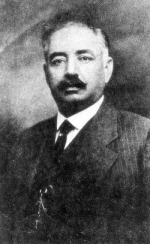 José María Maytorena was born in Guaymas on 18 July 1867, the son of José María Maytorena Goycochea, a prominent hacendado. His family was allies of the Pesqueiras, another land-owning family that had broken with Díaz, and his father had long waged political warfare against Torres and Corral, the state’s caciques, and stood as an independent candidate for governor. He owned eight haciendas on which he employed large numbers of Yaquis (thus coming into conflict with the government over their persecution of these Indians), silver and copper mines, and property in Guaymas.
José María Maytorena was born in Guaymas on 18 July 1867, the son of José María Maytorena Goycochea, a prominent hacendado. His family was allies of the Pesqueiras, another land-owning family that had broken with Díaz, and his father had long waged political warfare against Torres and Corral, the state’s caciques, and stood as an independent candidate for governor. He owned eight haciendas on which he employed large numbers of Yaquis (thus coming into conflict with the government over their persecution of these Indians), silver and copper mines, and property in Guaymas.